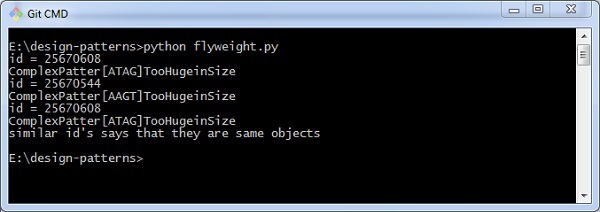Python 设计模式 - 享元模式(Flyweight Pattern)
享元模式(Flyweight Pattern)属于结构设计模式类别。 它提供了一种减少对象数量的方法。 它包括有助于改进应用程序结构的各种功能。 享元对象最重要的特征是不可变的。 这意味着它们一旦构造就无法修改。 该模式使用 HashMap 来存储引用对象。
享元模式是一种软件设计模式。它使用共享物件,用来尽可能减少内存使用量以及分享资讯给尽可能多的相似物件;它适合用于只是因重复而导致使用无法令人接受的大量内存的大量物件。通常物件中的部分状态是可以分享。常见做法是把它们放在外部数据结构,当需要使用时再将它们传递给享元。
Python 享元模式如何实现?
以下程序有助于实现享元模式 −
class ComplexGenetics(object):
def __init__(self):
pass
def genes(self, gene_code):
return "ComplexPatter[%s]TooHugeinSize" % (gene_code)
class Families(object):
family = {}
def __new__(cls, name, family_id):
try:
id = cls.family[family_id]
except KeyError:
id = object.__new__(cls)
cls.family[family_id] = id
return id
def set_genetic_info(self, genetic_info):
cg = ComplexGenetics()
self.genetic_info = cg.genes(genetic_info)
def get_genetic_info(self):
return (self.genetic_info)
def test():
data = (('a', 1, 'ATAG'), ('a', 2, 'AAGT'), ('b', 1, 'ATAG'))
family_objects = []
for i in data:
obj = Families(i[0], i[1])
obj.set_genetic_info(i[2])
family_objects.append(obj)
for i in family_objects:
print "id = " + str(id(i))
print i.get_genetic_info()
print "similar id's says that they are same objects "
if __name__ == '__main__':
test()
输出
以上程序生成如下输出 −


